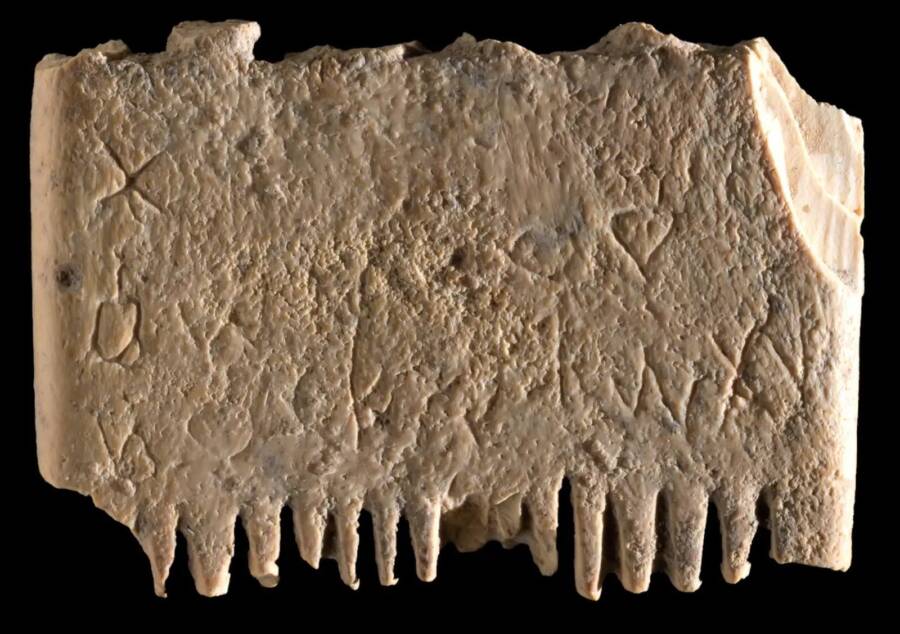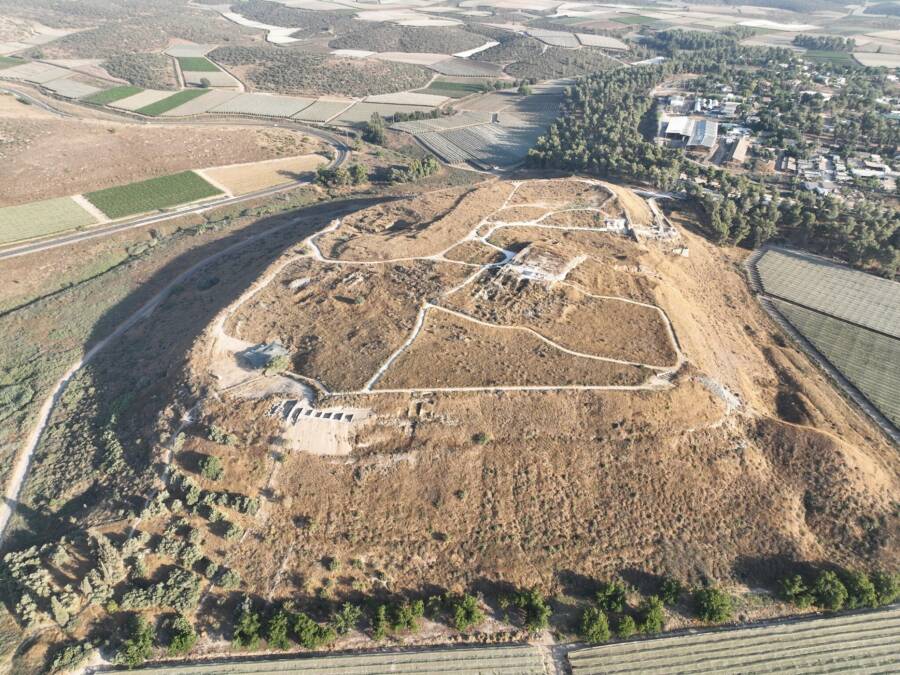This ivory comb from 1700 B.C.E. has an inscription in the Canaanite language that offers instructions on how to avoid lice.

Dafna Gazit, Israel Antiquities AuthorityThe comb contains the first-known written sentence in Canaanite, an ancient language.
In 2016, archaeologists in Tel Lachish, Israel, unearthed a 3,700-year-old broken ivory comb from an ancient trash pit. Though the find was set aside for years, researchers recently took a second look and made a surprising discovery. They realized that the comb actually bore an inscription — thought to be the first full sentence ever found in the earliest alphabet.
According to a study about the comb published in the Jerusalem Journal of Archaeology, the extraordinary find contains a rather mundane message. Written in the ancient language of Canaanite, it simply reads: “May this tusk root out the lice of the hair and the beard.”
Though the inscription may be simple, its historical implications are profound. According to The Guardian, the Canaanite comb sentence represents the oldest known sentence written in the earliest alphabet.
“This is the first sentence ever found in the Canaanite language in Israel,” Yosef Garfinkel, an archaeologist at the Hebrew University of Jerusalem who helped oversee the discovery of the comb, explained in a press release.

Daniel VainstubThe letters discovered on the ancient ivory comb.
“There are Canaanites in Ugarit in Syria, but they write in a different script, not the alphabet that is used [until] today… The comb inscription is direct evidence for the use of the alphabet in daily activities some 3700 years ago. This is a landmark in the history of the human ability to write.”
As Gizmodo reports, the comb is 1.38 inches by 0.98 inches and made from an elephant’s tusk. Though its teeth are broken, the comb once contained six teeth on one side meant to untangle hair, and 14 finer teeth on the other side meant to remove lice. According to a press release about the comb, it apparently did its job — researchers even found tiny remains of head lice.
Garfinkel told Gizmodo that the comb was probably made in Egypt — there were no elephants in Canaan 3,000 years ago — and then brought to present-day Israel where it was inscribed with its anti-lice message. The Times of Israel additionally reports that it appears that the comb’s inscriber carefully etched out 17 Canaanite characters, or seven words, but made the letters smaller and smaller as they ran out of space.
Because ivory was an expensive material, researchers believe that the comb probably belonged to someone of high social status. Clearly, however, their wealth didn’t protect them from the plight of lice.
“The fact that this inscription is about ordinary life is especially fascinating,” Christopher A. Rollston of George Washington University, who peer-reviewed the recent study on the comb, explained to the Times of Israel. “Throughout human history, lice have been a perennial problem. And this inscription nicely reveals that even ‘the rich and famous’ in ancient times (or modern times!) are not exempt from such problems.”

Emil AladjemA view of the ancient Canaanite city of Tel Lachish.
As Rollston told The Guardian, the world’s first writing systems originated in Mesopotamia and Egypt around 3,200 B.C.E. However, they were not alphabetic and instead used different symbols to represent words or syllables. The first alphabet emerged around 1800 B.C.E when people familiar with ancient Egyptian developed the early alphabetic Canaanite language.
Canaanite was used for centuries. It led to ancient Greek and Latin, which in turn led to many modern-European languages, according to The Guardian.
As a press release about the comb discovery notes, ten Canaanite inscriptions have been found in Tel Lachish, which is more than anywhere else in Israel. But the comb is significant because its anti-lice message makes up a complete sentence in the ancient language.
Yet there may be more discoveries in the ancient Canaanite city. As Rollston told the Times of Israel, the trash heap where the comb was discovered has offered up a number of other exciting finds as well.
“This Bronze Age inscribed comb joins a chorus of important inscriptions from this crucial ancient site, inscriptions dating to the Bronze and Iron Ages… and these inscriptions from the Bronze and Iron Ages are written in a variety of different languages and scripts,” he said. “Literarily, this is quite a site!”
After reading about the discovery of the oldest known written sentence, discover the story of the “hipster” medieval warrior buried with his beard comb. Or, discover the story of the Voynich Manuscript, the world’s most mysterious book.





